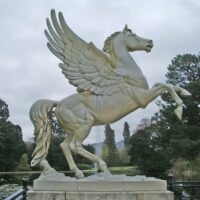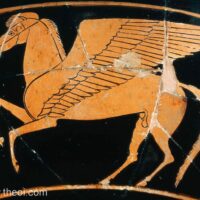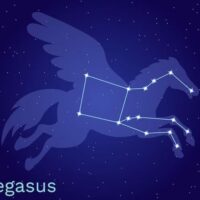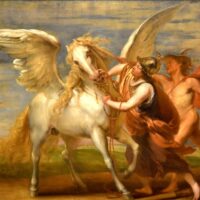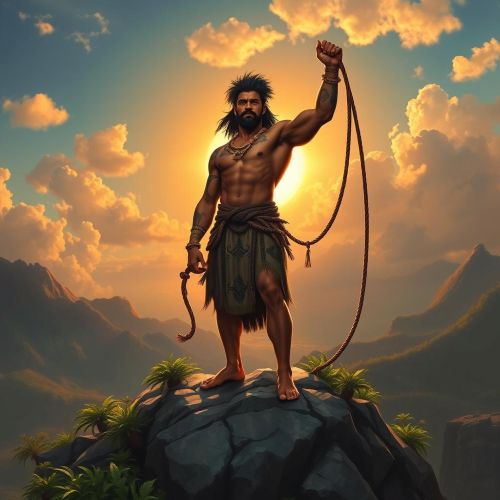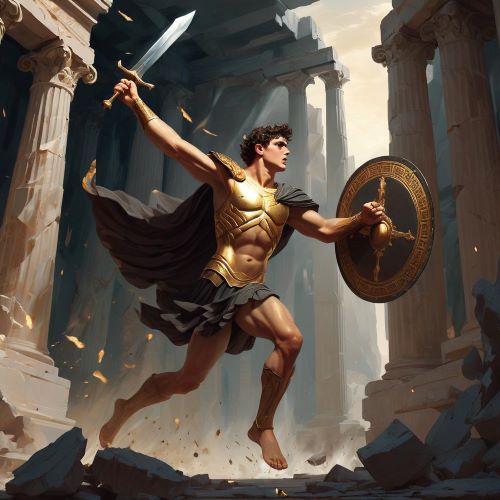Pegasus : The Winged Horse
Listen
At a glance
| Description | |
|---|---|
| Origin | Greek Mythology |
| Classification | Animals |
| Family Members | Poseidon (Father), Medusa (Mother) |
| Region | Greece |
| Associated With | Flight, Speed |
Pegasus
Introduction
Pegasus, a revered figure in Greek mythology, commands attention with its iconic presence. Often depicted as a radiant white horse adorned with expansive feathered wings, Pegasus embodies elegance and power. Throughout the annals of ancient tales, this majestic creature has remained a symbol of wisdom, fame, and inspiration, captivating the hearts and minds of generations. Its graceful flight and ethereal beauty have enchanted storytellers and artists for centuries, cementing its status as a legendary figure of unparalleled allure. Amidst the rich tapestry of Greek mythology, Pegasus reigns supreme, a timeless emblem of wonder and awe.
Physical Traits
Pegasus, often depicted as the epitome of beauty and grace, possesses a stunning white coat, reminiscent of freshly fallen snow, symbolizing his divine origins and purity. His mane and tail flow like strands of silk, shimmering in the sunlight as he glides effortlessly through the air. Radiating an otherworldly aura of divinity and power, Pegasus is a vision of strength and elegance.
The most distinctive feature of Pegasus is undoubtedly his magnificent wings, sprouting from his back with ethereal splendor. These wings, usually depicted as feathered and white to match his coat, allow him to take flight with breathtaking grace, soaring through the heavens with unparalleled freedom.
While ancient descriptions may vary in details, the core image of Pegasus remains consistent—a symbol of power, freedom, and the ability to transcend earthly limitations. Some accounts embellish Pegasus with a single golden horn on his forehead or shimmering hooves, further enhancing his celestial beauty. Regardless of variations, Pegasus is universally portrayed as a majestic creature, embodying the essence of strength, beauty, and the boundless possibilities of the skies.
Family
Pegasus, the illustrious winged horse of Greek mythology, traces his lineage to the union of the Gorgon Medusa and the god Poseidon. Following the heroic feat of Perseus in slaying Medusa, Pegasus emerged from her severed neck, a testament to his extraordinary origins. Despite his monstrous ancestry, Pegasus embodies purity and grace, transcending the darkness of his heritage.
The tale of Pegasus’s birth is steeped in the drama and violence characteristic of Greek myths. Medusa, once a stunning beauty cursed by Athena with a hideous visage and venomous snakes for hair, found favor with Poseidon, resulting in their union. Pegasus, born not through traditional means but rather from the severed neck of Medusa, embodies the convergence of the sea god’s power and the Gorgon’s chilling gaze.
Some renditions of the myth suggest that Pegasus emerged alongside his twin brother Chrysaor, a formidable giant, adding further layers to his lineage. From the moment of his miraculous birth, Pegasus stood as a symbol of extraordinary nature, embodying the essence of the sea and the fearsome legacy of his mother’s curse.
Other names
Pegasus, known as Pegasos in Greek, derives his name from “pegaios,” signifying “from the springs” or “from the wells,” a nod to the springs created by his hooves’ striking. While Pegasus is the most recognized appellation for this legendary creature, alternative names abound in ancient texts. In some narratives, he is referred to as Pegasos or Pegasa, while others dub him the “horse of the Muses,” indicating his association with the nine Muses of Greek mythology. Beyond the familiar moniker of Pegasus, various names hint at his diverse attributes and roles.
In certain myths, he bears the name Petyx, meaning “winged” in Greek, underscoring his paramount ability to take flight. Another epithet, Koios, translates to “keen of hearing,” perhaps referencing his acute senses essential for traversing the vast expanses of the sky. Additionally, he is sometimes called Triochestus, denoting “having three kinds of mane.” While this might allude to a mane of three distinct colors or textures, scholars speculate it could metaphorically symbolize his multifaceted nature—a divine entity, a formidable steed, and an emblem of inspiration.
Powers and Abilities
As a divine being, Pegasus possesses an array of extraordinary abilities that distinguish him from ordinary horses. Foremost among these is his remarkable power of flight, enabled by his expansive wings. With majestic strokes against the sky, Pegasus effortlessly ascends to great heights and traverses vast distances, transcending the limitations of terrestrial creatures. His unmatched speed allows him to cover immense spans in mere moments, a testament to his celestial lineage.
Additionally, Pegasus is credited with the creation of springs of water through the striking of his hooves upon the earth. In mythic tales, it is recounted that his footprints gave rise to Hippocrene, the legendary spring of the Muses, whose waters bestowed inspiration upon those who partook of them. This connection to the natural world underscores Pegasus’s role as a conduit between the earthly realm and the divine.
Moreover, Pegasus’s divine heritage endows him with immense strength, enabling him to bear burdens of considerable weight. Heroes like Bellerophon are said to have ridden upon his back, harnessing his power to accomplish mighty deeds. Some accounts even attribute to him the ability to ignite sparks from stones with his hooves, further accentuating his divine essence.
Beyond his physical prowess, Pegasus is intimately linked with inspiration and creativity. In tales woven by the ancients, Pegasus’s hoof strikes upon Mount Helicon are believed to have given rise to a magical spring from which flowed the waters of inspiration, serving as a fount of creativity for artists and poets alike. This association with the arts solidifies Pegasus’s role as a symbol of the boundless imagination, offering wings to those who seek to soar above the mundane and embrace the extraordinary.
Modern Day Influence
Pegasus’s influence extends far beyond ancient myth, leaving an indelible mark on modern culture across literature, film, and art. His iconic image adorns logos, notably gracing the emblems of airborne divisions within various military forces. Symbolizing freedom, speed, and inspiration, Pegasus remains a beloved figure in children’s literature and animated films, captivating audiences with his timeless allure.
In the realm of literature, Pegasus’s presence spans from classical epics like Homer’s Iliad and Odyssey to contemporary fantasy novels such as Rick Riordan’s Percy Jackson series. Artists have immortalized Pegasus in paintings, sculptures, and murals, portraying him as a symbol of boundless creativity and artistic inspiration.
Pegasus’s legacy thrives in popular culture, where he is celebrated as an enduring icon. From children’s cartoons to blockbuster movies, Pegasus enchants audiences of all ages, whether as a noble companion aiding heroes on epic quests or as a mystical creature traversing fantastical realms. His image continues to resonate in the modern world, a testament to the enduring power of Greek mythology.
In literature, Pegasus graces the pages of beloved series such as C.S. Lewis’s “The Chronicles of Narnia,” where he stands as a steadfast companion to the protagonists, and J.K. Rowling’s “Harry Potter” series, where his likeness guards the entrance to Gryffindor Tower. These portrayals underscore Pegasus’s timeless ability to ignite imaginations and inspire new tales, ensuring his place as an enduring symbol of heroism, freedom, and artistic inspiration in the hearts of readers and viewers alike.
Related Images
Frequently Asked Questions
What is lorem Ipsum?
I am text block. Click edit button to change this text. Lorem ipsum dolor sit amet, consectetur adipiscing elit. Ut elit tellus, luctus nec ullamcorper mattis, pulvinar dapibus leo.
What is lorem Ipsum?
I am text block. Click edit button to change this text. Lorem ipsum dolor sit amet, consectetur adipiscing elit. Ut elit tellus, luctus nec ullamcorper mattis, pulvinar dapibus leo.
What is lorem Ipsum?
I am text block. Click edit button to change this text. Lorem ipsum dolor sit amet, consectetur adipiscing elit. Ut elit tellus, luctus nec ullamcorper mattis, pulvinar dapibus leo.
What is lorem Ipsum?
I am text block. Click edit button to change this text. Lorem ipsum dolor sit amet, consectetur adipiscing elit. Ut elit tellus, luctus nec ullamcorper mattis, pulvinar dapibus leo.
What is lorem Ipsum?
I am text block. Click edit button to change this text. Lorem ipsum dolor sit amet, consectetur adipiscing elit. Ut elit tellus, luctus nec ullamcorper mattis, pulvinar dapibus leo.


